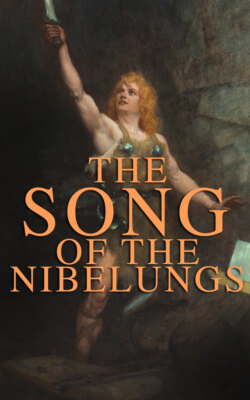Читать книгу The Song of the Nibelungs - Anonymous - Страница 8
На сайте Литреса книга снята с продажи.
3. The Saga as preserved in the Nibelungenlied
ОглавлениеThe saga as we find it in the German Nibelungenlied differs very widely in form and substance from the Northern version which has just been outlined, though the two have still enough points of similarity to indicate clearly a common origin. Each bears the stamp of the poetic genius of the people among whom it grew. Of all the sagas of the Germanic peoples none holds so prominent a place as the Nibelungen saga, and it may safely be said that the epic literature of the world, though offering poems of more refined literary worth, has none that are at the same time such valuable records of the growth of the poetic genius of two kindred peoples through many centuries of their early civilization as the Edda poems of this saga and the Nibelungenlied. It is impossible here to undertake a comparison of the two and point out in detail their parallelism and their respective significance as monuments of civilization; suffice it to indicate briefly the chief points of difference in the two stories, and note particularly those parts of the Nibelungenlied that have, as it were, suffered atrophy, and that point to earlier stages of the saga in which, as in the Northern version, they played a more important rôle.
First, as to the hoard. The Nibelungenlied knows nothing of its being taken by Loki from Andvari, of the latter's curse upon it, and how it came finally into the possession of Fafnir, the giant-dragon. Here it belongs, as we learn from Hagen's account (strophes 86–99), to Siegfried (Sigurd), who has slain the previous owners of it, Schilbung and Nibelung, and wrested it from its guardian the dwarf Alberich (Andvari). From this point onward its history runs nearly parallel in the two versions. After Siegfried's death it remains for a time with Kriemhild (Gudrun), is treacherously taken from her by Gunther (Gunnar) and Hagen (Hogni), and finally, before their journey to Etzel (Atli), sunk in the Rhine.
The protracted narrative of Sigurd's ancestry and his descent from Odin has no counterpart in the Nibelungenlied. Here we learn merely that Siegfried is the son of Siegmund. His father plays an entirely different part; and his mother's name is not Hjordis, as in the Edda, but Siegelind.
Of Siegfried's youth the Nibelungenlied knows very little. No mention is made of his tutelage to the dwarf smith Regin and preparation for the slaying of the dragon Fafnir. The account of him placed in the mouth of Hagen (strophes 86–501), how he won the hoard, the tarnkappe, and the sword Balmung, and slew the dragon, is evidently a faint echo of an earlier version of this episode, which sounds out of place in the more modern German form of the story. From the latter the mythical element has almost entirely vanished. It is worthy of note, moreover, that the very brief account of Siegfried's slaying of the dragon is given in the Nibelungenlied as separate from his acquisition of the hoard, and differs in detail from that of the Edda. Of Sigurd's steed Grani, his ride to Frankenland, and his awakening of Brynhild the Nibelungenlied has nothing to tell us. Through the account of Siegfried's assistance to Gunther in the latter's wooing of Brunhild (Adventures 6 and 7) shimmers faintly, however, the earlier tradition of the mythical Siegfried's awakening of the fire-encircled valkyrie. Only by our knowledge of a more original version can we explain, for example, Siegfried's previous acquaintance with Brunhild which the Nibelungenlied takes for granted but says nothing of. On this point of the relation between Sigurd and Brynhild it is difficult to form a clear account owing to the confusion and even contradictions that exist when the various Northern versions themselves are placed side by side. The name of the valkyrie whom Sigurd awakens from her magic sleep is not directly mentioned. Some of the accounts are based on the presupposition that she is one with the Brynhild whom Sigurd later wooes for Gunnar, while others either know nothing of the sleeping valkyrie or treat the two as separate personages. The situation in the Nibelungenlied is more satisfactorily explained by the theory that they were originally identical. But we see at once that the figure of Brunhild has here lost much of its original significance. It is her quarrel with Kriemhild (Gudrun) that leads to Siegfried's death, though the motives are not just the same in the two cases; and after the death of Siegfried she passes unaccountably from the scene.
But it is in the concluding part of the story—the part which, as we shall see, has its basis in actual history—that the two accounts diverge most widely. So strange, indeed, has been the evolution of the saga that the central character of it, Kriemhild (Gudrun) holds a diametrically opposite relation to her husband Etzel (Atli) at the final catastrophe in the two versions. In the Nibelungenlied as in the Edda the widowed Kriemhild (Gudrun) marries King Etzel (Atli), her consent in the former resulting from a desire for revenge upon the murderers of Siegfried, in the latter from the drinking of a potion which takes away her memory of him; in the Nibelungenlied it is Kriemhild who treacherously lures Gunther and his men to their destruction unknown to Etzel, in the Edda the invitation comes from Atli, while Gudrun tries to warn them to stay at home; in the former Kriemhild is the author of the attack on the guests, in the latter Atli; in the former Kriemhild is the frenzied avenger of her former husband Siegfried's death upon her brother Gunther, in the latter Gudrun is the avenger of her brothers' death upon her husband Atli.
